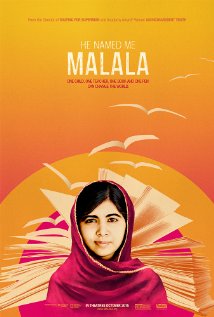
HE NAMED ME MALALA
US, 2015, 100 minutes, Colour.
Directed by Davis Guggenheim.
If ever a bullet did not achieve what the shooter intended it to do, it was that which the Taliban and fired into the head of the young student, Malala Yousafzai. The intention of the shooter was to kill Malala to make an example of her because she advocated education for girls.
Despite expectations to the contrary, when Malala was flown to Britain for surgery and for recovery, recover she did. And, although Malala is only 18 now, the rest is history.
This documentary, from director, Davis Guggenheim, who won the Academy Award for his Al Gore film, An Inconvenient Truth, presents a portrait of Malala as something of a jigsaw or patchwork quilt. His material is not presented in conventional chronological order. Rather, we are introduced to Malala, some information about her work as a young student in Pakistan, but then a focus on her recuperation, her becoming something of a public figure, her campaign for education for girls.
Interspersed throughout the film are animation pieces, a device used to move quickly over events and perspectives by offering sketched images of Malala herself as well has of the countryside and other backgrounds. Some have found this a bit disconcerting or not appropriate to such a serious subject. However, it does allow for a change of mood, a shift in perspectives, a way of getting the audience to reflect on what they are seeing and what it means.
With the emphasis on the title, it is clear that Malala’s father is quite a significant presence in her life. He often accompanies her. He is an educationalist with strong ideas, obviously a major influence on his daughter. By contrast, her mother is quiet and stays in the background. One of her siblings, her younger brother, offers some cheeky and playful comments about his sister. Malala herself is often playful.
One of the significant aspects of the film is Malala, after her recovery, pursuing her education, but also travelling widely to a variety of countries, especially in Africa, again to encourage girls to go to school and receive an education. She is a strong teenage missionary for female education.
It is only towards the end of the film that it focuses on Malala in Pakistan, the threats to education, her being shot, the immediate impact, strikingly visual, her being saved and brought back to health, and her appearance in headlines throughout the world.
It was thought that she would receive the Nobel Peace Prize in 2013, but this did not happen. She was pleasantly stoic about all of this. But, in 2014, she did win and, at the end of the film, we see her making her acceptance speech and her exhortations about education.
Malala has become a significant figure already – and it will be very interesting over the coming years to see how she manages her celebrity and how she continues her education campaign.